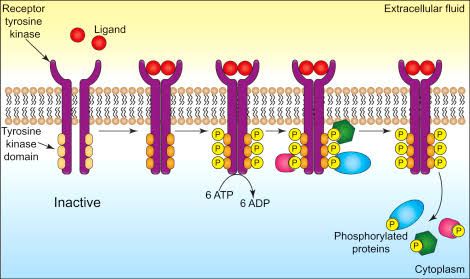
Classification of Enzyme-Coupled Receptors
Enzyme-coupled receptors are a class of membrane proteins that, upon ligand binding, activate intrinsic enzymatic activity or associate with enzymes to initiate signaling cascades. They can be classified into several categories based on their structure and function:
- Receptor Tyrosine Kinases (RTKs): These receptors have intrinsic kinase activity and phosphorylate tyrosine residues on themselves and other proteins.
- Receptor Serine/Threonine Kinases: These receptors primarily phosphorylate serine and threonine residues.
- Cytokine Receptors: These do not possess intrinsic kinase activity but recruit cytoplasmic kinases (like JAKs) upon activation.
- Guanylate Cyclase Receptors: These receptors convert GTP to cyclic GMP upon ligand binding.
Receptor Tyrosine Kinases (RTKs)
1. Structure and Function
Receptor Tyrosine Kinases (RTKs) are characterized by an extracellular ligand-binding domain, a single transmembrane helix, and an intracellular kinase domain. Upon ligand binding, RTKs dimerize and autophosphorylate on specific tyrosine residues, which creates docking sites for downstream signaling proteins.
2. Docking Sites for Proteins
The phosphorylated tyrosines serve as docking sites for various signaling molecules containing SH2 (Src Homology 2) or PTB (Phosphotyrosine Binding) domains. This recruitment leads to the activation of multiple signaling pathways, including those involving Ras, PI3K, and PLCγ.
Activation and Regulation of Ras
Ras is a small GTPase that acts as a molecular switch in signaling pathways.
Activation
- Guanine Nucleotide Exchange Factors (GEFs): Upon RTK activation, GEFs facilitate the exchange of GDP for GTP on Ras, activating it.
- Ras-GTP then interacts with downstream effectors like Raf, leading to the activation of the MAP kinase pathway.
Regulation
Ras is regulated by:
- GAPs (GTPase-Activating Proteins): Accelerate the hydrolysis of GTP to GDP, turning Ras off.
- GEFs: Activate Ras by promoting GTP binding.
Activation of MAP Kinase Signaling Module
The MAP kinase pathway involves a cascade of three kinases:
- MAPKKK (e.g., Raf) activates
- MAPKK (e.g., MEK) which then activates
- MAPK (e.g., ERK).
This cascade results in phosphorylation of various substrates leading to cellular responses such as proliferation, differentiation, or survival.
Insulin Receptor-Mediated Signaling
The insulin receptor is a well-studied RTK that regulates glucose homeostasis.
Mechanism
- Insulin binds to its receptor causing autophosphorylation.
- This activates IRS proteins which recruit PI3K.
- PI3K converts PIP2 to PIP3, activating Protein Kinase B (PKB/Akt).
PI 3-Kinase/Protein Kinase B Signaling Pathway
- Akt promotes glucose uptake by translocating GLUT4 transporters to the cell membrane.
- It also regulates metabolism by inhibiting apoptosis and promoting protein synthesis through mTOR activation.
Cytokine Receptors and the JAK-STAT Pathway
Cytokine receptors lack intrinsic kinase activity but associate with Janus kinases (JAKs).
Mechanism
- Ligand binding induces receptor dimerization.
- JAKs are activated via trans-phosphorylation.
- Activated JAKs phosphorylate tyrosines on the receptor creating docking sites for STAT proteins.
- STAT proteins are phosphorylated by JAKs and then translocate to the nucleus to regulate gene expression.
Receptor Ser/Thr Kinases and TGF-ß Signaling Pathway
Receptor Ser/Thr kinases primarily include Transforming Growth Factor-beta (TGF-β) receptors.
Mechanism
- TGF-β binds its receptor leading to heteromeric complex formation between type I and type II receptors.
- The type II receptor phosphorylates the type I receptor which then activates Smad proteins through phosphorylation.
- Phosphorylated Smads form complexes that translocate into the nucleus where they regulate target gene expression involved in processes like cell growth and differentiation.
In summary, enzyme-coupled receptors play critical roles in cellular signaling through various mechanisms including RTKs activating Ras/MAPK pathways, insulin signaling via PI3K/Akt pathways, cytokine-mediated JAK-STAT pathways, and TGF-β signaling through ser/thr kinases.







